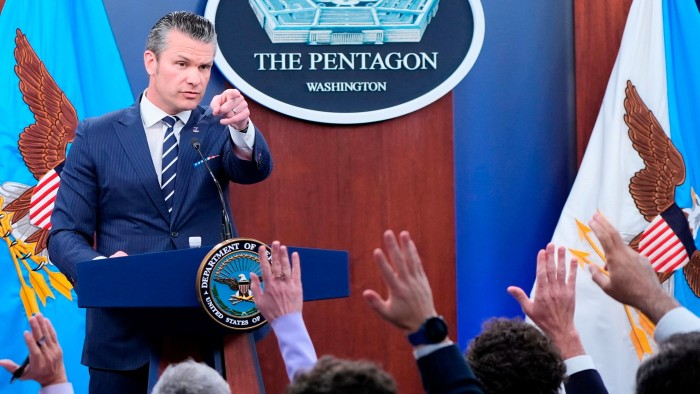Get the White House Watch newsletter for free
An overview of what Trump’s potential second term could mean for Washington, business, and the global landscape
This piece is a local version of our Unhedged newsletter. Premium subscribers can sign up here to receive the newsletter on weekdays. Standard subscribers may upgrade to Premium here, or check out all FT newsletters.
Good morning. There is only one major story dominating the markets and the world today. The potential effects on the market are difficult to determine. Everything depends on developments on the battlefield — a topic we won’t speculate on. However, we will provide some context and a few possibilities below. If you have insights, feel free to email us at unhedged@ft.com.
The US attacks Iran
President Donald Trump asserts that the US airstrikes on three Iranian nuclear sites over the weekend have “completely and totally destroyed” them, along with Iran’s capability to build a nuclear weapon. Whether this claim is accurate remains uncertain. However, the repercussions are unpredictable.
The next moves will be dictated by the Tehran regime, which is significantly weaker now than it was just months ago. Its primary ally in the region, the Assad regime in Syria, has collapsed, and its main proxies, Hezbollah and Hamas, are in a state of turmoil. Additionally, Iran’s military has also been weakened following a series of Israeli strikes. The Iranian regime now finds itself with little to lose.
For the markets — although they’re not the most crucial aspect of this situation — the risks are becoming clearer. The most optimistic outcome is that Trump has made a correct assessment: Iran’s government might choose to deescalate and pursue a negotiated deal with the US and Israel.
Alternatively, Iran could respond by shutting down the Strait of Hormuz, the waterway through which 20% of the world’s daily oil shipments pass. Last week, market volatility suggested traders were weighing this scenario; it now appears increasingly plausible. If the strait were to close, a spike in oil prices would be inevitable. As of Sunday night, the market was reflecting just a hint of this possibility — WTI futures increased from $74 per barrel to $77 when markets opened on Sunday night, while Brent crude surpassed $80 per barrel, although both have since retreated. If the Strait remains blocked for an extended time, leading to a stronger and prolonged rise in oil prices, global growth could suffer more than already projected; inflation would rise, and the Federal Reserve might reconsider any plans for rate cuts this year. Additionally, stock prices would likely dip. S&P 500 futures fell slightly on Sunday night, and significant Asian indices like the Hang Seng and Kospi experienced minor declines, although the changes were less severe. How deeply and how long the economic impact is felt will depend on Iran’s actions and the world’s responses.
The most dire scenario would be an escalation that involves the US in a prolonged conflict. Iran might target US military bases and assets in the vicinity. However, even that may not spark a major market reaction, especially if global oil supplies are uninterrupted. Markets actually rose following the US invasion of Afghanistan in 2001, although that was part of a broader recovery post-9/11:

Markets also increased leading up to the US invasion of Iraq in 2003 after numerous threats from President George W. Bush, but flattened afterwards:

Furthermore, markets climbed when the US intervened in Libya in 2011:

These experiences only provide limited lessons. The economic and political circumstances were unique in each situation. Of the three countries, only Iraq exports more oil than Iran, and none possess the same level of control over vital shipping routes.
Even if there are no immediate effects on oil supplies or the profits of major global firms, a conflict could have repercussions in the Treasury market. The US deficit is already on a concerning trajectory, and markets have not embraced Trump’s proposed Big Beautiful Bill. Should the US adopt a wartime approach, its budget may need to expand further. This would initiate a complicated interaction between Congress, the White House, the market, and the Fed. Lawmakers and the market could push back against increased spending, and Trump might attempt to urge the Fed to maintain low yields to facilitate further borrowing. Numerous potential outcomes exist. However, it is important to recognize that Treasury yields might rise from current levels. The benchmark 10-year Treasury future prices slightly declined on Sunday night. Concerns regarding the budget? It’s too early to determine the impact. This narrative will unfold over weeks and months to come.
We hope for peace — not for the sake of markets, but for those caught in the conflict.
(Reiter)
A Recommended Read
Dollar lending.
FT Unhedged podcast

Can’t get enough of Unhedged? Tune into our new podcast, offering a 15-minute update on the latest market news and financial headlines, twice weekly. Catch up on previous editions of the newsletter here.
Newsletters You May Like
Due Diligence — Highlights from the corporate finance world. Sign up here.
The Lex Newsletter — Lex, our investment column, explores the week’s key themes with analysis from award-winning writers. Sign up here.


